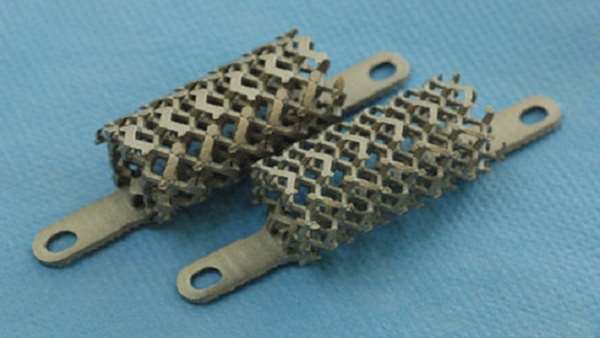How metal scaffolds enhance the bone healing process
The treatment of large bone defects in the upper or lower extremities (for instance, as the result of acute trauma, infection or bone cancer) remains a challenge in the field of trauma surgery. Bone defects of this kind do not heal on their own and, in particularly severe cases, will result in amputation of the affected limb.
The treatment of large bone defects in the upper or lower extremities (for instance, as the result of acute trauma, infection or bone cancer) remains a challenge in the field of trauma surgery. Bone defects of this kind do not heal on their own and, in particularly severe cases, will result in amputation of the affected limb. One treatment option available is to use the patient"s own bone tissue to produce bone grafts of the correct size and strength. However, this technique has often been of limited success. An alternative treatment option, offered by Charité’s Center for Musculoskeletal Surgery, is to treat large bone defects using individualized titanium-mesh scaffolds designed to fit the individual patient.
This technique uses CT scan data to produce a 3D model of the affected bone and the bone defect. Using a 3D printer with laser sintering technology, these data are then used to manufacture a titanium scaffold to patient-specific requirements. The customized structure is then surgically implanted into the affected bone. Results of this procedure have been promising, with a total of 19 patients at Charité having so far been treated using this type of implant.
To promote bone regeneration, the titanium-mesh scaffold is filled with the patient’s own bone tissue, growth factors, and bone replacement material. Led by Dr. Anne-Marie Pobloth (Julius Wolff Institute at Charité), an interdisciplinary team – comprising trauma surgeons, engineers, veterinary surgeons and biologists – has been studying whether mechanical optimization of the titanium-mesh scaffold might further enhance the healing process. “We started by using computer modeling to mechanobiologically optimize a standard-size scaffold. Using a large animal model, we were then able to study its actual effects on bone regeneration. As the process of bone regeneration is very similar to that found in humans, we were able to make inferences regarding bone healing in humans,” explains the veterinarian.
The optimized scaffold has a honeycomb-like structure, which is aligned to form channels that help guide the ingrowth of bone. By altering the strut diameter of the honeycomb, the researchers produced structures of varying stiffness. “We assumed that bone regrowth would vary according to the stiffness of the implanted scaffold. Therefore, in order to study the effects of mechanical stimulation during the bone regeneration process, we used four test groups receiving implants of varying stiffness” explains Prof. Dr. Georg N. Duda, Director of the Julius Wolff Center for Biomechanics and Musculoskeletal Regeneration and Deputy Director of the BCRT. With unequivocal results, explains trauma surgeon PD Dr. Philipp Schwabe, “Even after only three months, radiographic evidence showed that soft implants, produced faster bone growth in response to increased mechanical stimulation than stiffer implants.” The biomechanical properties of the implant affected both the quantity and quality of newly-formed bone, as well as on the type of bone formation produced within the scaffold.
The team are now planning to produce mechanobiologically optimized, softer titanium-mesh scaffolds, both ensuring patients can benefit from their findings and making it easier to treat bone defects. Rather than being restricted to use with the long bones of the arms and legs, it is also conceivable that this method may be able to be used in spinal, oral, and maxillofacial surgery.
Reference:https://www.charite.de/en/service/press_reports/artikel/detail/wie_metallstrukturen_effektiv_helfen_knochen_zu_heilen/





ارسال به دوستان